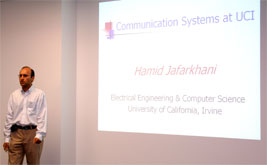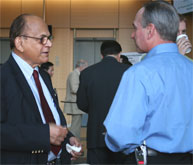UCI Communications and Networking Symposium Examines Network Interoperability
|
October 9, 2006 -- Nearly 140 eager industry, government and academic participants flocked to a communications and networking symposium funded by the UC Discovery Grant Program at the Calit2 Building at UC Irvine on Sept. 27. Attendees heard from industry and government experts regarding the benefits and challenges inherent in developing network-centric communications systems.
The event, which was cosponsored by Calit2 and OCTANe, also showcased the capabilities of UCI faculty members in the developing field.
Moderated by OCTANe President and CEO Gary Augusta, the symposium began with three experts who discussed combining infrastructure, privacy and security to create the next-generation network-centric operations system.
Sheryl Sizelove, chair of the technical council of the Network Centric Operations Industry Consortium and director of NCO architecture engineering at The Boeing Company, envisions a “net-enabled future.” According to Sizelove, the three major pieces of network-centric operations are: technology, which enables information sharing; operational doctrine, which describes how people organize and interact in a net-enabled environment; and culture, which involves the willingness to change, trust and delegate in order to enable new systems to succeed.
|
||||
While NCO is “all about being more effective,” Sizelove said there are issues that arise in achieving an NCO system. “NCO characterizes a new operational doctrine that leverages new capabilities, organizational structures and behaviors,” she said. Challenges include transitioning from “stovepipe” systems, which are often point-to-point and non-networked, into service-oriented architectures. Concerns about security and control of data, as well as limited budgets and cultural resistance are other constraints.
The NCOIC’s 80 members include Boeing, IBM, Motorola, Intel, Microsoft and Lockheed Martin. The consortium is working to develop a network-centric environment that provides assured technical interoperability, encourages open standards, educates on common principles and practices, and seeks to enable increasing levels of interoperability. Sizelove used post-disaster mobile emergency communications as an example of the importance of NCO. Interoperability of communications among medical services, branches of the military, 911 operators, fire departments, and local, state and national civil agencies is critical in emergency situations.
Robert Fox, a co-program manager of the Los Angeles Joint Regional Intelligence Center , told the audience that information sharing is a vital aspect of his agency. JRIC is a terrorism intelligence and analysis organization that incorporates the L.A. Police Department, L.A. County Sheriff’s Department, The Department of Homeland Security and the Federal Bureau of Investigation. It also supports regional and local protection initiatives by collecting information, converting information into operational intelligence, and disseminating it to prevent terrorism and combat crime. Network-centric operations are essential due to the amount of information processed and the number of groups involved. “We share and exchange information – including assessments, situation reports, advisories, warnings and alerts – with a wide range of public and private organizations,” Fox said.
David Flessas, vice president of network operations for Sprint Nextel Network Services, is responsible for surveillance, remote management and maintenance of the company’s wireless and wireline networks.
Sprint Nextel operates more than 2,000 servers, 132 platform/products, 62,690 IP ports and 36,000 miles of fiber, so integrated architecture is indispensable. Flessas said it’s also cost-effective, flexible and reliable. “Sprint is an integrator across multiple suppliers,” he said. “That gives us the ability to leverage previous efforts for new services. Integrated products – both wireless and wireline – will be the key to differentiating us from other companies.”
The evening also featured UCI professors who presented their networking and communications-related research in breakout sessions.
Presenters included: Hamid Jafarkhani, (communication systems’ physical layer); Ramesh Jain and Athina Markopoulou, (multimedia applications); Kevin Tsai (content-based network design and operation, and network management); and Tatsuya Suda and Stephen Jenks (protocol, architecture, and database design and operation).
The UC Discovery Grant Program provides matching funds for California-based companies and UC researchers to collaborate in a variety of technology-related areas. In addition to communications and networking, those areas include digital media, electronics manufacturing and new materials, information technology for life sciences, and biotechnology.



